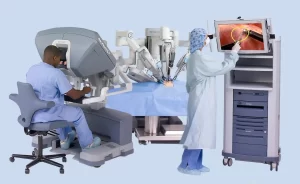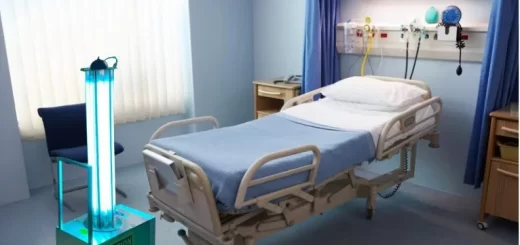Top trending topics on Surgical robotic systems, Importance and risks of robotic surgery
Surgical robotic systems are a revolutionary advancement in medicine, offering a minimally invasive and highly precise alternative to traditional open surgery. These systems have transformed the way surgeons perform complex procedures, resulting in numerous benefits for patients.
Surgical robotic systems
Surgical robotic system offers 3-dimensional images, allowing surgeons to operate with advanced vision, the robotic system utilizes an Endo-Wrist, an instrument with a 360-degree range of motion. Robotic surgery allows the surgeon to control the robotic system and to perform more precise and complex operations.
People who have robotic surgery may benefit from small incisions with minimized scarring, Better incision closure and stapling due to the steadiness of the robotic system and advances in instrumentation, Less pain and discomfort after surgery, Lower rate of postsurgical complications, Ability to go home the same day or have a shorter hospital stay, A quick recovery and return to normal activities.
Computer-assisted surgery holds great promise in various surgical fields, Robotic surgery is still a relatively new technology, but it is becoming increasingly popular. In 2021, there were over 1.5 million robotic surgeries performed in the United States.
Robotic surgery is minimally invasive. Surgeons make smaller incisions than they would with traditional open surgery. This can lead to less pain, scarring, and blood loss, as well as a faster recovery time. The da Vinci Surgical System has four robotic arms that are controlled by the surgeon using a console.
The da Vinci Surgical System has a 3D camera that provides the surgeon with a magnified view of the surgical field. It is equipped with tremor-filtering technology that helps to steady the surgeon’s hands.
The da Vinci Surgical System is the most common type of surgical robotic system. It was developed by Intuitive Surgical and was first approved by the FDA in 2000 and has been used to perform over 6 million surgeries worldwide.
Advantages of surgical robot operating system
Surgical robotic surgery has many benefits over traditional surgical procedures, surgeons do not have direct contact with the patients and the procedures can be completed through a three-dimensional vision system and an action calibration system, the movements of the surgeon’s arms, wrists, and fingers are recorded by the sensors in the computer and translated to the robotic arms.
Surgical robots are capable of operating fine surgery in a small space, They offer a high-definition 3D view of the operating area, They can magnify the surgical field by 40 times and the surgical action by 10 times, Robotic surgery is more precise than traditional open surgery. because the robotic arms can move in ways that human hands cannot. This allows surgeons to perform more delicate and complex procedures.
Surgical robotic systems provide surgeons with unparalleled precision and dexterity, allowing them to perform intricate and delicate maneuvers with greater control and accuracy. The robotic arms filter out any tremors or unintentional movements from the surgeon’s hands, enabling them to make smaller, more precise incisions and manipulate delicate tissues with greater finesse.
Surgical robotic systems are equipped with high-definition 3D cameras that provide surgeons with a magnified, immersive view of the surgical field. This enhanced visualization allows surgeons to see anatomical structures in much greater detail, enabling them to identify and target specific areas with pinpoint accuracy.
The minimally invasive nature of robotic surgery results in reduced blood loss and trauma compared to traditional open surgery. This is due to the smaller incisions required, which minimize tissue damage and disruption to blood vessels.
Patients who undergo robotic surgery experience shorter hospital stays and faster recovery times than those who undergo traditional open surgery. the smaller incisions and reduced trauma lead to less pain, inflammation, and scarring.
Surgical robotic systems perform many procedures, including hysterectomies, prostatectomies, and gallbladder removals. They are used to perform more complex procedures, such as heart surgery and brain surgery. As technology continues to advance, the applications of robotic surgery are expected to expand further.
Surgical robotic systems enable remote surgery, where surgeons can perform surgery on patients located in different cities or countries such as Antarctica and the International Space Station. This technology could revolutionize healthcare delivery, particularly in underserved areas with limited access to specialized surgical care.
Robotic surgery is used in many procedures such as Gynecological surgery, Urological surgery, General surgery, Cardiac surgery, Thoracic surgery, and Head and neck surgery. Surgical robotic systems represent the future of surgery, offering a more precise, minimally invasive, and patient-centered approach to surgical care.
Disadvantages of surgical robotics systems
Robotic surgery is not right for everyone. Some patients may not be good candidates for robotic surgery, such as those who are very obese or have certain medical conditions.
Robotic surgery is more expensive than traditional open surgery. However, the long-term benefits of robotic surgery, such as a faster recovery time and reduced risk of complications, may offset the higher cost.
You can subscribe to Science Online on YouTube from this link: Science Online
You can download the application on Google Play from this link: Science Online Apps on Google Play
Robotic Surgery vs. Laparoscopic Surgery, Robot-assisted surgery features, benefits and drawbacks
Surgical robot types, advantages, disadvantages, How is robotic surgery different from traditional
Healthcare robotics, Nursing care robots review, types, advantages, disadvantages and uses
Robot-Assisted Heart Surgery types, benefits, risks, Robotic heart vs. open-heart surgery
Interventional radiology types, Robotic endovascular systems advantages and disadvantages




